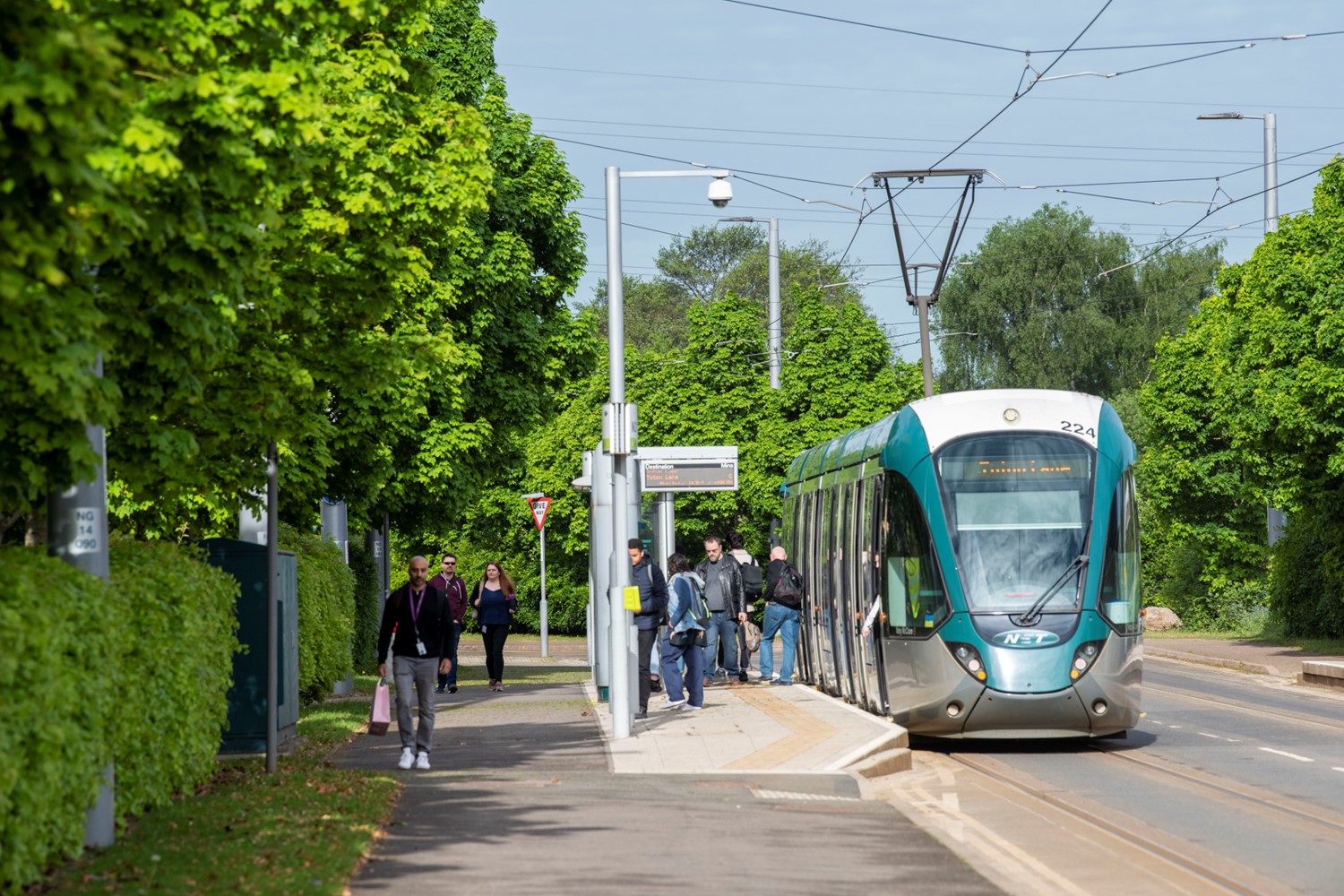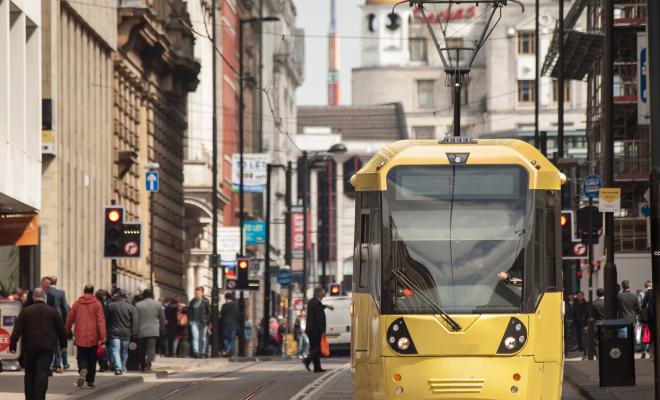20 Sep 2024
How is Action 7 tackling the climate crisis?
Parking levies limit congestion, cut emissions and can raise millions of pounds to help fund high-quality public transport networks.
Nottingham’s workplace parking levy, introduced in October 2011, was the first of its kind in the Western Hemisphere. A trailblazing example, it's still the UK’s only workplace parking levy, despite a decade of successful operation and a highly replicable model. A workplace parking levy is a charge on employers who provide workplace parking spaces. This tackles congestion in 2 ways:
- Incentivising employers to reduce their parking provision.
- Helping to fund major transport infrastructure.
In Nottingham, the charge only applies to employers who provide 11 or more parking spaces. Smaller employers are 100% discounted, as are spaces for disabled people, NHS premises and emergency services. The current charge per parking space is £500 a year for 2024-25, payable by the employer. All revenue raised from Nottingham’s levy is ringfenced by law to be spent on improving local transport.
Nottingham has one of the UK’s strongest public transport systems. This is, in no small part, thanks to its workplace parking levy.
What impact has this had?
Emissions impacts
- By September 2023 over 9,000 tonnes of CO2 emissions, equivalent to the annual emissions of 5,758 cars, had been saved since the levy’s introduction.
- The levy has contributed to a 33% fall in carbon emissions in Nottingham since 2005.
- The levy has paid for the electrification of 15 buses, which has saved 350 tonnes of CO2.
Investment in public transport
- £103 million of revenue has been raised directly from the levy.
- Having the levy in place helped Nottingham to secure inward investment of over £1 billion in transport, including £570 million for the tram network, a £60 million renovation of its train station, the expansion of the city’s electric bus fleet, and £1 million in grants via the Workplace Travel Service to help employers make sustainable transport options available for employees.
- A 17.5 km tram extension part-funded by the levy carries 20 million passengers a year.
Less congestion and better air quality
- Levels of nitrogen oxides and particulate matter emissions have reduced, leading to fewer cases of respiratory illness.
- 3 million private car miles have been eliminated because of public transport infrastructure improvements.
- Congestion growth has been cut by 47%.
- The levy enabled Nottingham to become the first local authority in the country to have its Air Quality Management Plan approved by the UK government without needing to create a charging Clean Air Zone.
Business investment and local jobs
- Tram and train station redevelopments led to the employment of 1,200 people.
- Public transport infrastructure has encouraged businesses to relocate to Nottingham.
- The tram network now serves 20 of the largest 30 employers in the city.
- In its first decade of operation, the levy has seen £1 million in grants given to local businesses for sustainable transport improvements via the Workplace Travel Service.
- Employers are saving £8 million a year and the wider Nottingham economy £16 million due to reduced congestion growth, which would have increased the time that employees and goods spend stuck in traffic.
“[The levy] was seen as a tax on business. It was seen as just another cost that they’ve got to deal with. Some businesses passed on the cost to their staff, others absorbed it themselves where they could, but it’s been really positive in so many ways for the city, and I think people now accept it as being in a good place like Nottingham which is a good place for business."
David Person, Director of Partnerships at East Midlands Chamber
“The excellent transport links made Nottingham the ideal location for our new business. Clients are able to use the bus, tram and train network to meet us and discuss their investment opportunities, and the accessibility has broadened the talent pool when we recruit.”
Ironclad Investments
Fareshare Midlands, one of the many businesses that has benefited from the levy, is the region’s largest food redistribution charity. At the Nottingham warehouse, there are 28 staff and numerous volunteers attending the site throughout the week. Some people were already cycling to work, but there was nowhere to put their bikes or cycling gear. Fareshare Midlands launched an Active Travel scheme and was keen to support more staff and volunteers to cycle.
With support from Nottingham’s Workplace Travel Service, which is funded by the levy, Fareshare Midlands was awarded a £13.5 k grant towards the cost of buying an anti-vandal bike shelter with sliding gates and a mechanical coded lock, plus a Sheffield cycle rack. The grant also included the cost of lockers and safety equipment, bike locks, lights, helmets, fluorescent sashes and a heavy-duty bike pump.
“We applied for the Workplace Travel Service grant to support our active travel initiative at Fareshare Midlands. From the first enquiry to the council, the support has been tremendous. Communication was upheld throughout the whole project to offer guidance where needed... The cycle shelter is already proving its worth, with many bikes being locked up safely and positive feedback from our staff. In addition to this work, the Workplace Travel Service has been fantastic at signposting us to local organisations such as Sustrans and Dr Bike, who’ve come on site to run engagement and promotional activities.”
Pierce O’Connor, Projects and Programmes Manager at Fareshare Midlands
Social impacts
- Nottingham is a more equal city, with more opportunities for disabled people and the 38% of residents without private vehicles.
- There’s more physical activity due to new opportunities for active travel. The first decade of the levy has seen more than £55 million spent on improving the city’s cycling and active travel facilities, with over 300 miles of new or upgraded cycle paths.
- A 2023 passenger survey found that over 70% of travellers rated Nottingham’s public transport system with 4 or 5 stars out of 5.
What made this work?
A clear public transport vision
Before the scheme began, Nottingham already had high public transport usage, as well as strong tram and bus networks and cycling schemes. This was a product of the council’s passion for public transport. Councils should know exactly why they’re implementing a levy and have a strong vision for what to do with the income raised.
Financial efficiency
From the council’s perspective, the levy was financially attractive. It would provide a guaranteed revenue stream at relatively low set-up costs, and be quicker to set up and cheaper to run than alternative options (such as Clean Air Zones or a standard congestion charge).
Benefits for business
The council were successful in making the business case for the levy and proving that congestion was an economic threat. Before the levy, congestion was estimated to cost Nottingham £160 million a year, with most of this cost borne by business. Therefore, employers were set to directly benefit from the levy and even make savings. In some cases the levy can be cost-neutral for employers by reclaiming part or all of the cost from employees, although the impact on employees needs to be considered, especially at a time of falling disposable incomes.
Stakeholder engagement and public consultation
It's important to have transparent channels of communication with stakeholders, particularly business, alongside informal and public consultation with members of the public.
Compliance-focused approach
The council decided to follow an ethos of compliance rather than enforcement. As much assistance as possible is given to employers, who are supported and guided, not punished or antagonised. This approach has achieved a 100% compliance rate to date among liable employees.
What resources were needed?
Nottingham was selected by central government to develop a workplace parking levy. It was therefore co-funded by Nottingham City Council and central government. Total set-up costs amounted to £3.1 million. However, any councils looking to replicate the scheme would enjoy markedly lower costs and risks, because Nottingham has already done the heavy lifting in devising a feasible model and is on hand to offer advice. The time needed would be reduced too. Provided the political will and relevant resources were available, a new levy could be set up within 2 to 4 years, or a single electoral cycle.
As the levy is a licensing scheme, it requires no infrastructure investment. In Nottingham, employers manage their own accounts for paying the levy online, making administration even more low maintenance. Operational costs are £500,000 a year. Nottingham City Council has created its own consultancy service on workplace parking levies, headed by Jason Gooding and Nigel Hallam. Even so, the whole levy system is operated by a team of fewer than 10.
A properly resourced project team is essential to establishing a major initiative like a workplace parking levy. Trying to cut corners won’t work, so it’s worth putting the right resources behind it.
Lessons from Nottingham
There are few barriers to other councils adopting a workplace parking levy along the lines of the Nottingham model. Funding, of course, is always a concern for councils, but while they may not receive the same level of central government input as Nottingham did being the pioneer, other councils will benefit from lower overall costs.
Proactive communications strategy and engaging employers
A major hurdle faced in Nottingham was early predictions about business and investors being scared away by the levy. These fears haven't transpired. Quite the opposite in fact: business has flourished, and the sophisticated public transport system has been a key attraction. Other councils have the advantage of Nottingham’s example to point to as evidence should similar doubts be encountered elsewhere.
A workplace parking levy will always be controversial. Councils need to be prepared to address this. It’s critical to have a highly effective communications campaign from the outset. It’s important to be proactive and not let any misinformation go unchallenged, especially on social media or in local press. In Nottingham, the communication strategy included mailouts to over 5,000 employers, workshops, and one-on-one meetings.
The benefits of the parking levy can feed positively into other public debates. When the Nottingham levy was launched, air pollution wasn’t the hot topic it is now, nor had so many councils declared a climate emergency. Nottingham proudly communicates about the improvements to air quality and the way that Nottingham residents are better connected to jobs, education and healthcare due to the public transport improvements.
“The argument about a levy being a tax on working people is frustrating, because a workplace parking levy is imposed on employers, not individuals. It is not a tax on motorists – more than half of employers don’t pass on the charge. You need a well developed communications campaign, with some key figureheads going out there and getting your message across.”
Nigel Hallam, Workplace Parking Levy Service Manager, Nottingham City Council
Built-in flexibility
The flexibility of a levy should help subdue controversy. Any given levy can be tailored to its specific context. The size of the charge, the geographical area covered, exemptions, discounts and support packages are all details that can be adjusted. This adaptability should counter arguments about such levies being a tax on working people at a time when in-work poverty is a growing problem. If crafted carefully, there's no reason why working people shouldn't benefit from such schemes, for example through improved public transport links and cleaner air.
The impact of coronavirus shouldn't be taken lightly. Nottingham saw liable parking spaces fall by 50% in the first 2020 lockdown, though even during subsequent lockdowns the council still collected substantial levy revenue. The number of liable places has since returned to a “new normal,” around 77% of pre-pandemic spaces.
As remote and hybrid working have become a regular part of working life, the council adapted the levy operating model in 2023 to ensure it remains fit for a post-pandemic world. The peak parking period is no longer 5 days a week but is instead condensed to Tuesday-Thursday.
Nottingham has also hired new staff for an on-the-ground “intelligence-led” approach. By having more staff out and about inspecting parking at employers’ premises, the team can be more versatile. For example, there’s a lot of construction ongoing in the city, with contractors travelling in from outside who may be unaware they’re using parking spaces liable for the levy. The new approach is about spotting opportunities and being responsive to each employer’s unique situation.
Importance of ring-fencing revenue
Another key lesson is that such levies are most effective when revenue is targeted. By making it a legal obligation to spend revenue only on public transport, Nottingham City Council has been able to maximise the impact of its initiative. Another lesson is the necessity of a thriving vision for public transport and the political fortitude needed to realise it.
“The Nottingham workplace parking levy scheme is now seen as business as usual. It has delivered what it said on the tin, so there is no reason why other councils shouldn’t at least consider one to see if it’s right for them. Nottingham has a huge amount of unique experience in all aspects of the scheme, and we can support other local authorities at every stage.”
Nigel Hallam, Workplace Parking Levy Service Manager, Nottingham City Council
Displaced parking
Councils should be ready to manage any issues with displaced parking (increased traffic stress inside and outside the zone of the levy). Nottingham has a displaced parking working group comprised of staff from highways, traffic management and other teams within the council. The group addresses pressure points as and when they arise in several ways: limited wait zones, junction protection, restricted 4-hour parking, limited parking but no return within a specific time, paid parking etc. All these interventions can be funded by the levy itself. Having a long-term traffic management plan and being alert to the issue means Nottingham has successfully managed additional parking stress.
Useful information
If you're interested in setting up a workplace parking levy in your own city, please contact:
- Nigel Hallam at [email protected]
- Or [email protected]
- Or by phone on 01158 765050.
For an academic evaluation of Nottingham’s Workplace levy, please see the University of Loughborough's research.
Learn more in this webinar Workplace Parking Levy Schemes: From Policy to Practice.
Related projects
Many other councils have considered setting up their own levy, but at the time of writing none have implemented one. Councils that have looked into a levy or taken steps towards one include Hounslow, Leicester City, Oxfordshire, City of Edinburgh, Glasgow City, Cambridge City, Bath and North East Somerset, and Bristol City.
Friends of the Earth's view
More councils, especially in urban areas, should consider introducing a parking levy to raise money for public transport improvements. Nottingham has shown how to convince businesses and deliver multiple benefits.
Other councils may wish to consider alternative ways to raise money such as Community Investment Bonds (Action 8 of the Climate Action Plan).
The government could help by giving local authorities more powers to raise funds locally, such as a payroll levy which is common in France.
Friends of the Earth is showcasing specific examples of good practice in tackling climate change, but that doesn’t mean we endorse everything that council is doing.
This case study has been produced by Ashden and Friends of the Earth. It was originally published in February 2022 and was last updated in April 2024. Any references to national policy in this case study relate to policy under the previous government and reflect the policy context in which the council was operating at the time.








